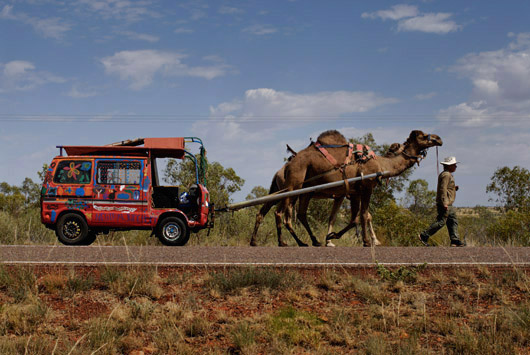Australia,
sulle tracce di Chatwin venti anni dopo Le Vie dei Canti
Palazzo Ducale, Genova
Australia, in Chatwin's footsteps twenty years
after The Songlines
Palazzo Ducale, Genoa


Da
cinque anni viaggia a piedi insieme a loro. Li ha trovati nel deserto
attorno a Kata Tjuta. E li ha addomesticati, se così si può
dire, lui che “domestico” certo non è. Willy ha ora
9 anni, Snowy 8; Klaus 60, i primi venti passati in Germania, poi Australia.
Perché «mi piaceva andare in giro e l’Australia era
bella e facile». Klaus ha fatto l’operaio fino a 55 anni,
poi «stufo di avere sempre qualcuno che mi diceva cosa fare»,
ha lasciato tutto e ha cominciato a camminare. Perché i cammelli?
«È capitato così», un po’ per caso, forse
per la lentezza. Dettano loro il ritmo all’andatura, con soste frequenti
per brucare e ripartenze rapide. Nel furgoncino-casa che si tirano dietro
c’è anche un cane, Oskar, 6 anni, che non ce la fa ancora
a camminare a lungo, «sta imparando» dice Klaus. Un viaggio
simile l’aveva compiuto la scrittrice australiana Robyn Davidson
a fine anni Settanta, 1700 miglia attraverso il deserto con quattro cammelli
e un cane. Chatwin era amico di Robyn, che gli aveva presentato molte
delle persone con cui aveva stretto amicizia ad Alice Springs mentre scriveva
“Tracce”, il racconto della sua traversata fino all’oceano.
In Australia i cammelli selvatici sono cresciuti a dismisura. Introdotti
a migliaia nell’Ottocento, e abbandonati con l’arrivo della
ferrovia, si stima che oggi siano circa mezzo milione. Un paio di anni
fa si era sviluppato un dibattito su come eliminare l’eccesso di
cammelli che aveva conseguenze disastrose su colture e fonti d’acqua,
spingendosi a ipotizzare di sparar loro dall’elicottero o ammaestrarli
e venderli all’Arabia Saudita. Per ora continuano a essere liberi.
Come Klaus, che con Willy e Snowy percorre più o meno quattromila
chilometri l’anno. E pensa di non fermarsi, almeno ancora per vent’anni